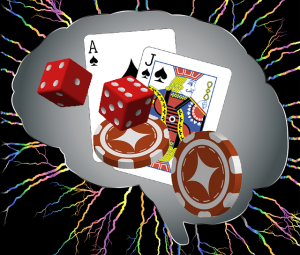The Human Gambling Condition: Apophenic fallacy or subliminal messaging?
 The human brain is an incredible thing of enigmatic beauty. I’s like the perfect computer, running on its own, super-powered, self-charging battery. Scientists have yet to discover all of the things our miraculous brains are capable of, as they’re still busy trying to understand so many of the abilities they’ve uncovered so far.
The human brain is an incredible thing of enigmatic beauty. I’s like the perfect computer, running on its own, super-powered, self-charging battery. Scientists have yet to discover all of the things our miraculous brains are capable of, as they’re still busy trying to understand so many of the abilities they’ve uncovered so far.
One such concept is the way our minds process information. Our brain is like a transponder. We constantly send and receive messages. Each message we receive, we must interrupt before deciding whether to send out a response, and if so, what response is appropriate.
The most enigmatic aspect of human existence is that we are all unique. A group of 100 people may all respond exactly the same to one message, but completely different to another.
Aside from extenuating circumstances, a red traffic light will make everyone stop. However, if asked their favorite food, everyone might respond differently to this same message. More often in life, a majority will respond in one way, while a minority will issue a range of varying responses. Watch any episode of the TV game show, Family Feud, and you’ll understand my meaning.
Psycho-Semantics of Conscious vs. Subconscious Information
The way messages are received can greatly effect the response range, as well. Most information is received consciously, such as the red traffic light, or a survey question. Maybe we see a baby in its mothers arms and it makes most of us smile. Then again, there are subconscious messages our brain deals with all the time. We don’t even know it’s happening, because again – it’s subconscious.
The subconscious is defined by The Oxford Dictionary as:
…the part of the mind of which one is not fully aware but which influences one’s actions and feelings.
According to physiologists, Information Theory states that the average human can gather as many as 11,000 bits of information per second, but that the conscious mind can only process 5 to 9 bits per second. The subconscious mind, however, is capable of processing at a rate of 20,000 bits per second.
Think of it as a computer that’s processing information. If the computer must display each bit of information as it processes it – as the conscious mind does in relaying the information to us – then it wouldn’t process nearly so fast. Allow the computer to process information without showing us every bit of it as it’s processing, and we retain so much more.
You’re probably wondering at this point how this has anything to do with gambling or casinos. The relationship can be linked in two ways; first through a clinical psychology term known as apophenia – one most of you probably aren’t familiar with – and second by way of subliminal messages – a term you’ve surely heard of before.
Apophenia and the Human Gambling Condition
Apophenia is defined as:
The tendency to perceive a connection or meaningful pattern between unrelated or random things (such as objects or ideas)…
Apophenia is, at its core, the driving force behind another phenomena known as ‘The Gambler’s Fallacy‘. It is our brain’s tendency to take random things and try to find reason, logic and patterns within, for the purpose of predicting a future outcome that is, in all reality, based on chance. It is the urge we get to bet on black at the roulette table after seeing red hit three times in a row.
A roulette wheel does not operate past on past performance. Every spin is independent. There are 18 red and 18 black positions on a European roulette wheel. If it weren’t for the green 0, there would be a perfectly even, 50/50 chance of red or black appearing every single time the wheel is spun. If red lands three times in a row, the odds of black landing next will not increase or decrease in any way.
A perfectly logical, conscious thinker, will deduce this correctly. However, those who suffer from apophenia will see it as a pattern and convince themselves that black is more likely to come next. They will bet on black. They may even be so convinced that they increase their bet size. It is, for many, the root of compulsive gambling behavior, convincing one’s self that they are “due for a win”.
Do Casinos Really Use Subliminal Messages?
If you’ve seen some of the old black and white films from the 1950’s, you might think subliminal message are so obvious that no casino could put one past you. But subliminal messages can be sent in many more ways than a .003 flash of an image or text. They are designed to trigger your subconscious into action, and casinos are very good at doing that.
When you walk onto the casino floor, the first thing you’ll probably notice is the horrifically gaudy carpet. All those colors jumbled together with no conceivable rhyme or reason, when in fact, there’s a very good reason. The carpets are made to hurt your brain so that you will not look down at them, but rather up, at all the action going on around you. This is where the real messages are.
The constant chiming of slot machines, combined with flashing lights and random appearances of words like “Jackpot”, “Winner”, and “Super Mega Win”, are meant to convince you that these machines pay out so much money, on a constant basis, that you can be a winner just as easily.
That waitress/waiter that appears to be flirting with you? Yes, they are flirting, but not because they are interested in you. It’s because they are paid to do it, subconsciously increasing your confidence in all things – your appearance, your luck, your ability to win.
Look around any casino. There are no clocks. There are no windows. Everything that’s happening continues to happen all day, every day, morning, afternoon, evening and night. There is no delineation of time in a casino. If you don’t realize how much time you’ve spent here, you’re more likely to stay longer, and spend more money in the process.
Purposeful Subliminal Deception by Casinos
Sometimes, the subliminal messages are more deceitfully targeted, such as showing split-second messages on a video poker or slot machine. In 2007, the Ontario Lottery and Gaming Corp (OLG) was caught doing just that, although they never admitted it.
A patron caught on video a slots game flashing jackpot images for .02 seconds during the game. The OLG temporarily pulled 87 of its machines, but at that time, there were approximately 22,000 of them positioned across the province of Ontario, Canada. The manufacturer of the machines waved it off as a software glitch.
Conscious or Subconscious, Responsibility is the Key to Safe Gambling
Some of us may be more susceptible to apophenia. All of us will interpret subliminal message in different ways. As I said, the human brain is an enigmatic thing, and we are each individually unique in the way we send, receive, and process both conscious and subconscious information. It certainly makes you wonder if these conditions are what determine who will and won’t display at-risk and/or high-risk behavior for gambling addiction.
My hope is that, in sharing this scientific information with you, we are able to make more conscious decisions – more responsible decisions – when playing casino games. Because in the end, responsibility is what defines us as a safe or harmful gambler.





